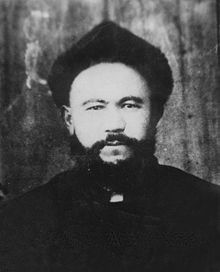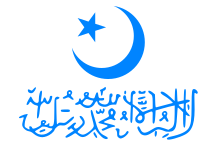Sabit Damulla Abdulbaki
Sabit Damulla or Sawut Damollah ( Chinese 沙比提 大 毛拉 , Pinyin shā bǐ tí dà máo la , Arabic ثابت داملا عبد الباقي, DMG Ṯābit Dāmullā ʿAbd al-Bāqī , Uighur داموللا سابىت ئابدۇلباقى, Yengi Damolla Sabit Abdulbaⱪi ); (born in 1883 ;. died 1934 ) was a leader of the Uighur independence movement , the Hotan -Rebellion against the government of Xinjiang under Jin Shuren led and later against the Uighur leader Hoxha Niyaz fought. He was the sole prime minister of the short-lived Islamic Republic of East Turkestan from November 12, 1933 until the republic was overthrown in May 1934.
Life
Sabit Damulla Abdulbaqi was born in the Atush area in Vilayet Kashgar in 1883 and received a religious education. In the 1920s he graduated from the Academy of Politics and Law in Xinjiang in Urumqi (later Xinjiang University in Chinese 新疆 大学 , Pinyin Xīnjiāng Dàxué ). The university was founded by Governor Yang Zengxin in 1924 and offered courses in Chinese, Uighur and Russian. After graduating from university, he went on trips to the Middle East, including Egypt , Turkey and Saudi Arabia ; he also traveled to the Soviet Union , where he completed further studies. In 1932 he returned to Xinjiang en route through India and joined the Emir Muhammad Amin Bughra as the latter was preparing a rebellion in the Hotan district . Sabit Damulla had no illusions that Islamic powers would support Uighur independence and looked for a connection with other great powers . Yang Zengxin had closed his publishing house in Artux because Damulla was spreading Jadid ideas.
Career
Damulla also founded an independent government in Hotan on March 16, 1933, which he proclaimed together with Muhammad Amin Bughra. This government later extended its power to Kashgar and Aksu . Through the "East Turkestan Independence Association" he was able to exert a wide range of influence and prepare the proclamation of the Republic in Kashgar on November 12, 1933. Between November 12, 1933 and February 6, 1934 he was elected Prime Minister of the Islamic Republic of East Turkestan in Kashgar. While Damulla preferred the unofficial term "Republic of Uigurstan", Muhammad Amin Bughra rejected this term because he wanted to create a broad anti-Chinese and anti- Dungan front in Xinjiang that united all Turkish peoples. Hodja Niyaz , the leader of the Kumul rebellion of 1931, was invited by Damulla to Kashgar to take over the presidency of the republic.
death
Contemporary sources believe that Damulla was captured by Hodja Niyaz in Aksu and then extradited to Sheng Shicai . He was hanged in Urumqi in June 1934 . Later sources claim that Sheng held him in Urumqi but used his skills as a translator as a commodity for his treatment in prison. Chinese Muslims, such as Kuomintang officer Liu Bin-Di, obtained a Koran and other Arabic and Sino-Islamic texts for him to translate into Uighur. it is not known whether he was able to complete this task. Liu Bin-Di himself was shot in Gulja in November 1944 during a revolt that led to the establishment of the Second Republic of East Turkestan .
Aftermath
The Islamic Turkestan Party , a terrorist organization, published in its magazine Islamic Turkistan ( Arabic تركستان الإسلامية, Uighur ئىسلامى تۈركىستان, Issue 12) a photo of the founders of the First East Turkestan Republic with Sabit Damulla Abdulbaki under the title: “Men who made history with their blood”. ( Arabic رجال سطروا التاريخ بدمائهم)
The al-Qaida ideologist Mustafa Setmariam Nasar praised the “Republic of East Turkestan” of Damulla, the “leader of the Islamists”.
Literature & web links
- Mark Dickens: The Soviets in Sinkiang (1911-1949) . USA 1990. oxuscom.com - academia.edu
- Michael Zrazhevsky: Russian Cossacks in Sinkiang. Almanac “Third Rome”, Moscow 2001.
Individual evidence
- ^ Ondřej Klimeš: Struggle by the Pen: The Uyghur Discourse of Nation and National Interest, c.1900-1949 . BRILL, January 8, 2015, ISBN 978-90-04-28809-6 , p. 122.
- ↑ James A. Millward: Eurasian Crossroads: A History of Xinjiang . Columbia University Press, 2007, ISBN 978-0-231-13924-3 , pp. 203-.
- ↑ Nabijan Tursun: The influence of intellectuals of the first half of the 20th century on Uyghur politics . ( Memento of the original from October 12, 2016 in the Internet Archive ) Info: The archive link was inserted automatically and has not yet been checked. Please check the original and archive link according to the instructions and then remove this notice. In: Uyghur Initiative Papers. Central Asia Program, December 11, 2014, p. 2.
- ^ Institute of Muslim Minority Affairs: Journal of the Institute of Muslim Minority Affairs, Volumes 4-5 . King Abdulaziz University, 1982, p. 299 (Retrieved June 28, 2010).
- ↑ (1933-1352)) featuring the caption "Founders of an independent islamic state in the Hijri year 1352 in East Turkestan" (مؤسسوا دولة إسلامية مستقلة عام 1352 هـ في تركستان الشرقية). Aaron Y. Zelin: Ṣawt al-Islām presents Issue # 12 of Ḥizb al-Islāmī al-Turkistānī's [Turkistan Islamic Party] magazine: "Turkistān al-Islāmīyyah" | JIHADOLOGY: A clearinghouse for jihādī primary source material, original analysis, and translation service . Retrieved May 13, 2016.
- ↑ رجال سطروا التاريخ بدمائهم. Safar 1434 AH. Archived from the original on April 23, 2016. Info: The archive link was inserted automatically and has not yet been checked. Please check the original and archive link according to the instructions and then remove this notice. Retrieved October 21, 2015 ..
- ↑ Mustafa Setmariam Nasar (aliases Abu Musab al-Suri and Umar Abd al-Hakim): Muslims in Central Asia and The Coming Battle of Islam . 1999, archive.org
| personal data | |
|---|---|
| SURNAME | Abdulbaki, Sabit Damulla |
| ALTERNATIVE NAMES | Zawut Damollah; ثابت داملا عبد الباقي (Uighur); 沙比提 大 毛拉 (Chinese); shā bǐ tí dà máo la (pinyin); سابىت داموللا عبدالباقى |
| BRIEF DESCRIPTION | Uighur-Chinese Prime Minister of the First East Turkestan Republic |
| DATE OF BIRTH | 1883 |
| PLACE OF BIRTH | Artux , Chinese Empire |
| DATE OF DEATH | 1934 |
| Place of death | Urumqi |


